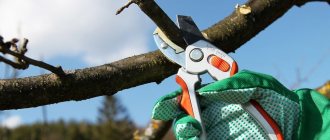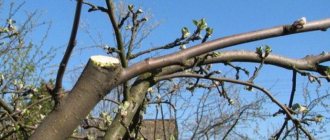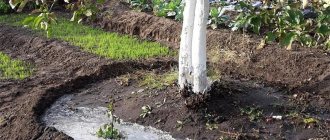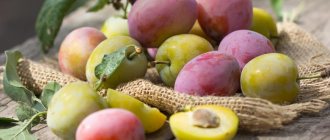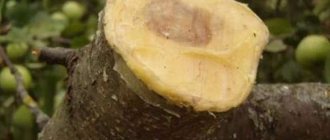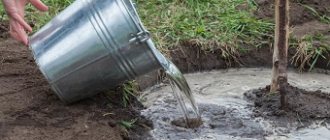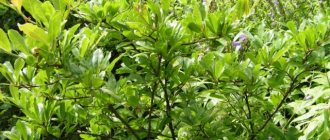Pruning maple formation in autumn
Proper pruning of maple in the fall.
Read in today's article how to form a maple crown yourself? Where to start pruning maple? Which branches need to be pruned? Pruning and shaping maple in autumn
Maple is an ornamental plant in garden design. It is often used by landscape designers, since the plant is easy to work with, the leaves are decorative, and, moreover, delicate inflorescences are formed that add beauty to the area. After planting, the gardener is not left alone with labor-intensive care - the rules for maintaining a maple tree on the site are so simple that even a beginner can cope with them.
When to prune maple:
- At the end of winter and at the beginning of spring.
- Autumn.
Early spring pruning is a standard step in maple care. The tree is being prepared for the new season. Autumn pruning is necessary to prepare the maple for wintering. At the end of summer it begins to gradually shed its leaves, and by mid-autumn it is almost completely bare. Pruning maple in the fall is aimed at removing old branches and the primary formation of the crown.
We focus on age
An annual maple planted on the site is formed at a height of 0.5 m - in pruning, they are guided by 2 well-developed shoots. They cut off mainly the lower branches and work with the side areas to increase branching. From the first year of life, the crown is formed.
The two-year-old maple has already survived several winters on the site, so there will be frozen and broken branches. It is necessary to remove damaged areas, leaving active shoots.
From the age of three, you can work with the main or central shoot of the maple - form it 1.5-2 m from the ground. Young branches are still pruned to guide growth, branching and crown formation, as well as old ones for renewal.
How to form a maple crown in the fall:
- Cut 2 m from the ground.
- Formation of a streamlined, symmetrical crown.
- Removing old and damaged shoots.
- Working with lateral and central branches.
What are the benefits of pruning maple trees in the fall?
While studying material about pruning maple in the fall, we identified a common misconception among gardeners - maples are pruned only to restrain development. We were not talking about the formation of an aesthetic crown or even about the health of the tree. Yes, indeed, pruning helps to restrain active growth if you plan to care for a French garden . The decorative appearance of the maple tree is preserved from year to year, and the shape of the crown is perfected, but one should not forget about its beauty.
Pruning allows you to experiment with the shape of the maple crown: create an oval, spherical one, leave it spreading, give it a more oval appearance.
Precautions when shaping maple
Towards the end of the active period of development, the maple is weakened and gradually preparing to enter a period of rest. Autumn pruning can become traumatic - the wounds will not have time to heal by winter. Do not remove branches before the arrival of cold weather. Also let the cut areas dry and then cover them with garden varnish. How to cover the tree after trimming? Work especially well on young branches, which will dry out if they lose a lot of sap. In autumn pruning, focus primarily on old and damaged branches.
↓ Write in the comments when and how do you form a maple? Do you do autumn pruning?
Please rate the material you read :)
Planting maple and other trees on the site
Propagation of trees and shrubs by cuttings
This tree can be found on 3 continents; it amazes with its discreet beauty and exquisite charm. Beautiful trees of exotic species can grow up to 3-4 meters and have yellow-green leaves. This is a Japanese maple, which has recently become extremely popular. This type of maple will go well on a plot of land with willow and oak.
Some types of Japanese maple have red leaves that amaze even experienced landscape designers with their charm. Japanese "Mikawa nishiki" in autumn colors the leaves with green-ashy shades, which makes this maple unique. The “Ryuzu” variety colors tree leaves in bright, unusual shades in the fall. And an adult tree does not grow higher than three meters, which allows for an open view of other green spaces.
How to choose a maple for the site of a house or cottage?
You can choose a maple tree that will rise ten meters and can be used on large plots of land, allowing you to create artificial parks. Typically, sugar maple and false sycamore maple “Leopoldii” are used for this purpose.
The amazing red-leaved Tatarian maple maintains red leaves throughout the season. It can be planted on every site, since its height is small, and it will look organic anywhere. This tree can usually be seen in parks and on various plots of land as a decoration.
Maple also goes well with conifers. In addition, maple will look great next to larches, spruces, firs, oaks, birches, elms, and lindens.
For rocky areas, it is best to purchase low varieties of these trees. Low-growing varieties should be planted near bergenias and in rockeries, next to decorative stones.
And you can endlessly watch how the Japanese maple leaves gradually change color, just like flowing water and a burning flame in the fireplace. Acer palmatum's leaves are green in spring and then turn burgundy in autumn. Maple stands out among other large trees because it is perfect for urban conditions. This tree is even, with a rounded dense crown, and in the fall it acquires bright, elegant shades of the crown.
It should be remembered that in order to preserve these trees, it is necessary to cover them during the cold season in the first year after planting. Typically, maples are highly resistant to cold, even if the frosts are quite severe, but the seedlings need careful care at first. However, the sycamore maple requires constant protection from frost, as it can suffer from cold.
Maple pruning
Photo 1. Pruning maple crown in spring
Maples are excellent for landscaping garden plots, city alleys, parks, squares and other areas. It is easy to care for, but may require sanitary or decorative pruning. If overgrown branches have dried out or broken, they must be removed. The procedure allows you to preserve the plant and ensure the growth of young branches.
Pruning maple trees in summer is carried out only when damaged fragments pose a threat of collapse. Falling parts can injure passers-by and cause damage to infrastructure. The plant is characterized by active sap flow, so it is not recommended to prune it in spring and early summer. The tree may lose a lot of sap and dry out.
How to properly trim an old linden tree?
Photo 2. Trimming linden from an aerial platform
Mature green spaces need rejuvenation and healing. To do this, it is necessary to completely remove dry, old, broken and diseased fragments. In addition to sanitary pruning, structural pruning should also be performed. It involves cutting branches that:
- intersect;
- rub against the trunk;
- grow inside the crown;
- worsen the condition of the large size.
Is it possible to trim the top of a linden tree? Crowning a linden tree is done to stop the growth of branches. You can slow down their growth and reduce the crown using decorative or shaping pruning. The procedure is best carried out in summer or autumn. To ensure that sunlight penetrates the central trunk evenly from all sides, arborists thin out the crown. This operation involves the removal of heavily overgrown intersecting fragments.
Linden pruning in the fall should be done before frost arrives. These trees tolerate pruning well and quickly form healthy shoots. When removing branches, arborists adhere to cutting technology and use sharp and clean tools - pruners, saws, pliers and garden shears.
Prices for sanitary pruning and crowning
Unit change
| price, rub. | ||
| Sanitary pruning with dropping branches | 1 tree | 1 500 – 8 000 |
| Sanitary pruning with branches lowering | 1 tree | 2 500 – 12 000 |
| Crowning (decorative, anti-aging pruning) | 1 tree | 3 500 – 16 000 |
The table shows the average prices for sanitary pruning and crowning of trees; they may vary depending on the size of the tree, the degree of crowding and other factors.
Minimum order value 10,000 rubles.
Types and varieties of plants, appearance
Ginnala maple (original name - Acer ginnala) is a deciduous tree or shrub from the genus Maple. It has many of the features of a regular maple.
Listed below are the maple species considered to be the closest relatives of the Ginnala maple.
- red maple;
- Manchurian maple;
- Norway maple "Globosum";
- maple "Royal red";
- Tatarian maple;
- ash maple "Flamingo".
The Ginnala maple has a rather characteristic appearance; a description of its external features includes:
- General form. Most often a tree or shrub. This property depends on the pruning and the goals pursued by the gardener.
- Height. Small. The average height is 3-4 m. Sometimes taller trees are found - up to 10 m.
- Trunk. Smooth (only cracks a little over time), grayish. Diameter 20-25 cm.
- Crown. Dense, dome-shaped. Gives excellent shade. Crown diameter is about 6 m.
- Leaves. Bright, green, lobed (three lobes, the middle one is very elongated) with straight reddish cuttings. In autumn, the color of the leaves is very impressive - bright yellow, orange or red (the latter - most often).
- Bloom. In spring, after the leaves bloom. The flowers are small, yellow-green, and collected in racemes.
- Fruit. Paired lionfish. Has a reddish tint.
- Root system. Thick, superficial. Produces very extensive growth.
Cost of cutting dry branches
- Conditions of work:
the tree must have enough living branches for the arborist to lift.
Tree type
| Trunk diameter (at a height of 50 cm from the ground) | |||||||||
| up to 20 cm | 21-30 cm | 31-40 cm | 41-50 cm | 51-60 cm | 61-70 cm | 71-80 cm | > 81 cm | ||
| Dry branches make up less than a third of the tree's crown | With the ability to drop branches down | 1 000 | 1 500 | 2 000 | 2 500 | 3 000 | 3 500 | 5 000 | 6 500 |
| With the need to lower branches on ropes | 2 000 | 3 000 | 4 000 | 5 000 | 6 000 | 7 000 | 8 000 | 9 000 | |
| Dry branches make up more than a third of the tree's crown | With the ability to drop branches down | 1 500 | 2 250 | 3 000 | 3 750 | 4 500 | 5 250 | 7 500 | 9 750 |
| With the need to lower branches on ropes | 2 500 | 3 750 | 5 000 | 6 250 | 7 500 | 8 750 | 11 000 | 13 250 | |
- Brief technology of work:
an arborist climbs a tree using living branches;
removes dry branches and throws them down;
The branches are cut into pieces.
The price includes cutting the wood into pieces 1 m long and storing them at a distance of no more than 50 m.
If it is necessary to remove branches from neighboring trees or shoot a rope with a slingshot, the price may increase.
Loading of logging residues into a container, their removal and cleaning of the area is paid additionally.
Minimum order value 5,000 rubles.
See the following video to see how tree pruning work is carried out.
Video 1. Tree pruning by an arborist
Decorative varieties of spherical maple
There are several popular varieties of spherical maple:
- Golden Globe is the rarest variety of spherical maple, with golden foliage. An excellent addition to landscape gardens.
- Cleveland is a maple with a wide round crown and a tall trunk (compared to the generally accepted standards of a spherical maple). The flowers have a fruity aroma.
- Columnare is a medium-height tree with a small rounded crown. If you do not trim the crown, then as the tree ages it becomes conical.
- Crimson King is a tall maple with a rounded crown. It differs from other species in its dark, burgundy leaves and bright orange flowers.
- Crimson Sentry is a tall maple with red leaves. At the beginning of growth, it has an elongated crown shape, which later transforms into a spherical one.
- Deborah is a medium-sized tree with unusual leaves with wavy edges. The leaves of this spherical maple are purple at first, then turn green.
- Drummondii is a low tree with a wide crown. The leaves are framed with a white stripe. In youth, the crown is pyramidal, eventually turning into a ball. In practice, this variety does not bloom and is propagated by cuttings. Slowly developing.
- Emerald Queen is a medium-sized maple with bronze-pink leaves when blooming. The crown is initially ovoid, eventually turning into a ball.
- Faassen's Black is a maple with a wide crown, flattened on top. The leaves are dark purple.
- Globosum is a small maple with a dense spherical crown. It grows slowly. The flowers are fragrant. Tolerates frequent changes of growing sites. Adapted to high and low temperatures.
- Royal Red is a medium-height tree with original-colored leaves that are red when blooming and turn dark red over time.
Pruning maple: features
Photo 2. Arborist performs crowning of maple tree
An adult Norway maple grows to a height of 10-30 m. This tree has a strong trunk and massive branches. To cut off the emergency parts, you must seek the help of qualified arborists. They carry out operations using saws, sharp pruners, garden shears and other tools. Experts reach the cutting points using an aerial platform or using industrial mountaineering.
Pruning maple trees in the fall is the right decision. This is the best time to cut down damaged branches, as well as shorten and rejuvenate the crown. From September to December, sap flow is suspended, so branches can be cut without risk to the plant. It is not advisable to carry out operations in winter, since in frosty weather the tree reacts painfully to pruning, and the cut sites do not heal well.
Ash maple requires a special approach. Pruning it is often aimed at changing the growth pattern of branches, giving the crown the correct shape. The branches of this tree often form a spasmodic crown, which needs to be adjusted.
Rule No. 2. The most suitable standard plants for formation
With simple pruning you can get a standard plant from:
- Maple
- Pines
- Bird cherry
- Juniper
- Yew berry
- Rowan trees
- Common privet
Of course, you can experiment with plants, but these examples will probably be successful. The formation of such trunks begins during the period of rapid growth of young seedlings. During the growing season, side shoots are plucked out. Experts assure that the best standard plants are formed from trees/shrubs grown from seeds.
Ginnala maple: pruning and crown formation
Photo 3. Maple crowning.
This plant is a decorative plant. Its height is only 3-10 m, so it is important to control the growth of the crown. Pruning of the Ginnala maple is carried out for the purpose of:
- preventing branches from rubbing against each other;
- reducing the crown, giving it a neat appearance;
- plant rejuvenation, development of young shoots;
- eliminating diseased fragments, getting rid of infections;
- removing weak and underdeveloped branches that prevent healthy shoots from growing.
Basic methods of maple propagation
An expert from Greensad tells how to propagate maples:
- Maples are propagated by seeds with preliminary stratification under natural or artificial conditions.
- Maple propagates easily by root shoots.
- On an industrial scale, propagation by grafting onto ready-made root systems is used.
Video: how to properly propagate Norway maples. How to plant maples correctly
In the article you will read everything about the Ginnala maple, the photos of which amaze with their beauty, especially in the autumn. It contains information about the appearance of the plant, its use, and its care. If you want to decorate your site or create a hedge, then be sure to pay attention to this article!
Where can I order pruning at a good price?
Photo 4. Sometimes you can only trim a maple tree from a bucket truck
Experienced arborists from the Lesmaster company can trim deciduous trees carefully and in compliance with technology. We offer the best rates. If you need to trim a maple tree, you don’t know how to trim an ordinary maple tree with a ball, or give it another attractive shape, contact our specialists.
Pruning of common red maple, river maple and others can be ordered at sites in Moscow and the Moscow region. To have employees come to you, just call our office by phone or leave a request.
Why do you prune in the fall?
Tree pruning is a mandatory procedure necessary to better withstand the cold winter period.
It provides:
- Elimination of new shoots in need of nutrition. Unnecessary branches absorb the crop's supply of nutrients, as a result depleting it and causing a decrease in the number of fruits during the next season.
- Reducing the likelihood of branches breaking during heavy snowfall in winter.
- Saving time spent on caring and treating plants in the summer.
- Obtaining a bountiful harvest with high-quality, healthy and large fruits.
Features of circumcision
Pruning of fruit crops occurs in the fall, when all the possible harvest for that year has been harvested. The basic rule for this procedure is to reduce the possibility of harm to the fruit tree.
Improper pruning can lead to:
- to a decrease in fruiting;
- to improper crown formation.
In order for crop pruning to be beneficial, you should:
- pruning should be carried out only after the onset of frost, which reduces the likelihood of injury;
- adjust the number of shoots, but do not remove everything;
- remove all dried and diseased branches, providing the way for new and healthy shoots to grow next season;
- Before carrying out the procedure, familiarize yourself with the peculiarities of pruning on a particular crop.
The time when the movement of sap along the trunk and branches of the plant ends is considered optimal for pruning fruit crops. When holding an event in the summer, you can doom it to illness, thereby reducing its fruiting rate for more than one season.
The timing of pruning fruit trees differs depending on the region of the country. For example, in the southern regions of the country they can be pruned in the fall, but in the northern regions such an event is not recommended. This is explained by the fact that the crop bark may freeze out in winter at the cutting site. A young tree up to two years of age may die completely after autumn pruning.
All cut branches are not recommended for use as tinctures and decoctions for ingestion by the human body; it is better to burn them and use the ash as fertilizer.
Tree pruning patterns in autumn
It should be remembered that each crop has its own individual characteristics of crown formation, which must be taken into account when pruning a tree and forming its crown.
It should be taken into account that any branch pruning scheme is aimed at removing unnecessary branches, but not at destroying the main wood of the tree.
The pruning pattern depends on how neglected the tree is and how long ago this procedure was carried out.
For an unkempt tree, the pruning plan is as follows:
- Choosing the pattern of the future tree crown for its formation over several years.
- Trimming excess branches starting from the middle of the tree, from the driest and most damaged branches.
- It is recommended to leave young shoots in small quantities after the first pruning.
Hearth crops are pruned using two methods:
- shortening to form the height and width of the plant;
- thinning.
Where and how does it grow
- The natural habitat of this maple is Asia: it used to be and is now widespread in northeastern China, Japan, Korea and Mongolia.
- Many scientists, by the way, combine the Tatarian maple (a tree whose photo is identical to the hero of the article) and the Ginnala maple into one subspecies.
- But still, the second true name of the Ginnala maple is riverine maple, or riverside maple Ginnala. He received it due to the fact that he most often “settled” on the banks of rivers. Sometimes you can find maple in mountainous areas, as well as in light forests.
- Life expectancy is very high - up to 100 years, and there are specimens that are already more than 200 years old!
- Maple grows quite quickly, adding 20-50 cm in height and width every year.
- The qualities of the Ginnala maple are light-loving, unpretentious, frost-resistant, wind-resistant.
Types of cuts
When pruning a plant, it is important to make the cut correctly without damaging the tissue of the stem part of the crop.
You should remember the main rule of making cuts - you cannot damage the main tissue of the tree, namely the wood. If the procedure was carried out without unnecessary damage, the cut on the tree will quickly tighten.
- Trimming living branches . In this case, you cannot touch the wood of the main tree trunk. Initially, a pocket is found that forms under the place to which the branch is attached. The two main tasks of maintaining the health of the crop are to not cut off the excess part of the pocket and not to touch the wood in the area of the top fold.
- Trimming dry branches . In this case, the pocket and fold are quickly identified, after which an incision is made.
There are several types of cuts:
- The cut to the bud , made not too high above it, clearly in a horizontal profile, so as not to contribute to the penetration of infection.
- Kidney cut made at an angle. It is important not to damage the bark.
- Side branch cut for the purpose of adjusting the height or direction of plant growth.
- Cut to ring, applicable when pruning just one thick branch.
Dates
Correcting the state of the culture depends on:
- on the degree of its neglect;
- from damage to its crown and branches by diseases;
- from infestation and degree of pest damage.
The time frame for plant recovery varies depending on various circumstances:
- If the fruit crop has not been previously treated and has an outwardly neglected appearance, then it should take at least 5 years to restore it to a normal, well-groomed and healthy appearance. It is impossible to bring it back to normal condition in one year due to the need to cut off a large number of branches, which can significantly reduce yields for several years.
- When a crop is damaged by pests or disease, the affected branches are removed in one pruning. However, this procedure will reduce fruiting for many years. For this reason, in such situations the feasibility of restoring the diseased tree should be assessed. In some cases, a new plant can grow faster than an old one can recover.
The frequency of pruning depends on the age of the plants:
- On old trees, it is recommended to carry out pruning (usually rejuvenating) once every 3 years.
- Young crops should be pruned regularly to form a proper crown.
Rule No. 3. We do everything consistently
- When growing a seedling, make sure that the trunk of the plant is strictly vertical, so that there are no so-called rings or bends on it.
- If the shoot deviates from the vertical, tie it to a peg. Be sure to remove side shoots. You can also pinch them after the third leaf and then remove them after a year.
- In three to four years, a trunk one and a half to two meters high will grow from the seeds. A standard of young seedlings will grow a year, or even two, earlier.
- After mid-April, it is best to get vaccinated. To do this, take a cutting with 3-4 buds. In four weeks (or maybe three), buds will appear on the graft that has taken root. By autumn they will already become annual growths.
- Next spring you will need to cut them back into several buds in order to branch better. Subsequent care will be the same as for ordinary seedlings.
We invite you to familiarize yourself with the composition of Caucasian adjika
How to increase productivity?
Plant fertility is directly related to:
- With freedom of space . It is believed that the more branches, the less space for fruits. Therefore, you should regularly monitor the density of branches by cutting them in a timely manner.
- With tree health . Various crop diseases contribute to disruption of the flow of nutrients to the branches where the fruits should be located. The presence of pests can endanger already set fruits, which is guaranteed to prevent the owner of the crop from using them as food.
Additional measures
Additional measures to increase productivity include fertilizing tree roots. There are two types of fertilizers:
- natural , such as manure and ash from burnt dry twigs;
- artificial , manufactured at a manufacturing plant as a result of certain chemical transformations.
Important factors influencing crop yield are:
- influence of drafts;
- wind protection;
- exposure to sunlight;
- regularity of watering.
{SOURCE}
